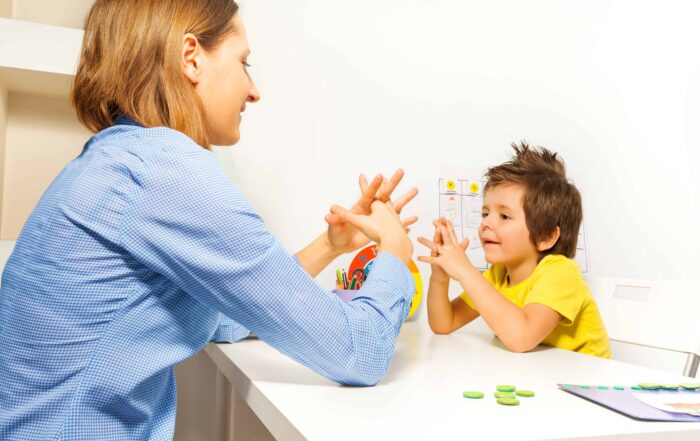Gray Atherton, Ph.D., discusses pet ownership as it relates to autistic individuals. She gives context for the importance of this topic, details the theories underpinning her research, and outlines her recent mixed-method studies. The speaker describes differences in the directness of animal communication compared to human social cues and underscores the positive relationship between pet ownership and mental health for autistic people. Atherton describes themes in her qualitative research, noting potential barriers and breakthroughs. The presenter provides ideas and solutions for future research and application directions and introduces the research team before opening the question and answer session.
Learn more about our speaker, Gray Atherton, Ph.D. HERE
Take the knowledge quiz HERE
In this webinar
0:59 – Agenda
1:55 – Introduction and context
3:31 – Theory behind animal connections and autism
5:15 – Eye gazing serotonin feedback loops
7:02 – Visual cues in animal interactions
8:58 – Mixed methods approach and study outlines
10:39 – Study: Autistic vs. non-autistic pet ownership survey
15:11 – Equal animal attachment across groups
17:15 – Pet attachment and mental health in autism
17:34 – Study: Real-life applications for pet contact
18:40 – Themes from research
19:25 – Sensory benefits
20:31 – Companionship
21:08 – Judgment
22:56 – Social lubricant
24:37 – Barriers
26:33 – Responsibility as a breakthrough
27:43 – Challenges
29:00 – Ideas, solutions, and future directions
30:54 – Volunteerism
32:09 – Mentoring
33:25 – Ways to start
36:25 – Presentation summary
37:26 – Research team
38:06 – Q & A
Summary
Research shows that autistic people prefer interactions with animals over humans and that 80% of autistic children have participated in pet therapy. This, the speaker asserts, gives context as to why pet contact in relation to autism is an important topic (1:55). The Biophilia Theory, as described in Atherton’s recent publication (3:31), asserts that humans innately love nature and seek connection with other forms of life (4:45). Most of human history, she continues, has been lived in a direct relationship with nature which allowed humans and domesticated animals to evolve in stride and foster a connection of love and affection (6:15). For example, studies have revealed that when humans and dogs exchange eye gazes both participants experience an increase in serotonin, creating a serotonin feedback loop. Therefore, humans have a profound physiological and biological connection with domesticated animals. (There is an emphasis on domestic animals as such feedback loops do not occur in gaze exchanges with wolves) (5:15).
Atherton explains that, although autistic individuals often avoid human eye contact, eyes are one of three focal points they consider when interacting with animals (7:02). The speaker implies this trend could be because animals give much more direct social cues than humans – as there are no contradictory social signals to puzzle together (i.e., contradicting words and facial expressions), animal behavior is more straightforward to interpret (8:03). The presenter details another recent study and the mixed method approach they used to discover outcomes and themes of pet ownership among autistic individuals (8:58):
Experiment 1: Researchers surveyed 700 adults, half of whom were autistic, on lifetime pet ownership, pet attachment, and mental health (10:39). Contrary to previous research, Atherton and her team found that autistic people are less likely to own pets as children and adults. They also found pet ownership corresponded with better life satisfaction (12:20). Atherton asks viewers not to distance this finding from its context, reminding them that the ability to own a pet likely corresponds with having a steady job and home, which innately increase life satisfaction. Pet attachment, she continues, is related to better mental health in autistic individuals (17:15). The study also found that autistic people use relationships with pets to compensate for social avoidance experienced as a result of social difficulties (16:15). Importantly, both groups exhibited equal attachment to pets, and the type of pet did not change the relationship quality (15:11). The presenter asserts that this fundamentally dismantles the assumed stereotype that autistic people lack emotional complexity and connection compared to the non-autistic population.
Experiment 2: Researchers interviewed autistic participants about pet experiences to understand what real-life applications exist for pet contact (17:34). Atherton lists themes found in the research (18:40) and details several benefits of having pets. Sensory benefits, for example, include the touch of fur and scales, weight of an animal on one’s lap, and the bidirectional calming interaction of petting an animal (19:25). Animals also offer a type of social presence that allows individuals not to be alone, but does not apply pressure to perform or conform (20:31). Further, the speaker shares, pets can offer a solution to masking because there is no judgment as animals accept care and love in whatever form it’s given, which boosts owner confidence and self-esteem (21:08). Pets can also act as a social lubricant, opening connections between family members and the community (22:56). Barriers discovered in the study included economic standing and a personal fear or anxiety that, as an autistic person, one cannot be responsible for taking care of another being (24:37). However, she continues, the responsibility of pet ownership seems to spur a breakthrough in self-confidence and independence as it provides motivation to care for someone else and, therefore, a reason to get up, put the video game down, and ensure employment and housing (26:33).
The presenter reviews the challenges found in these studies (27:43) and provides ideas and solutions for future directions (29:00). For example, if pet ownership is unavailable, volunteerism can allow for animal contact and simultaneously create a connection with a community and job experience (30:54). Atherton suggests ways to start preparing for pet ownership (33:25), including fostering, starting with smaller pets, getting advice from a mentor (32:09), and more. The speaker summarizes the presentation (36:25) before opening the question and answer session (38:06), where she discusses equine therapy (39:04), mental health indicators (41:20), benefits to early childhood development (46:11), hoarding (48:50), the effects of pet ownership on aggressive behavior (55:15), and more.
 About the speaker, Dr. Gray Atherton
About the speaker, Dr. Gray Atherton
Gray Atherton, PhD, has a BSc in Child Development from Vanderbilt University, a Master’s in Counselling from University of Houston, and a Ph.D. in Educational Psychology and Individual Differences from University of Houston. She has previously lectured at University of Houston and the University of Wolverhampton. Prior to entering academia, Gray was a counselor for adolescents with neurodevelopmental conditions. “I am interested in understanding how people with autism spectrum condition see the social world. Specifically, I explore individual differences in social processing and how these differences often found in people with autism also exist in the general population. I also investigate anthropomorphism, or seeing the human in the non-human, and how this relates to social processing in autism. To investigate this I am developing virtual reality techniques that allow for anthropomorphic experiences. My other research interest lies more broadly in embodied social processing. I am particularly interested in how movement can affect the way we see ourselves and our social partners, and how this can be used to understand special populations.”
Take the knowledge quiz
Can’t see the quiz below? Take it online HERE
Caregiver Strategies for Building Infant Social Interaction
Free webinar at 1 p.m. Eastern time (US), Wednesday, October 9, 2024 Tune in to hear Dr. Laurie Vismara discuss Infant Start, the Downward Extension of the Early Start
Editorial – Addressing delays: proactive parent-led interventions during waiting periods
The wait for an autism diagnosis and subsequent intervention can be highly stressful for many families, especially when access to needed health and educational services also hinges on the approval of insurance
Sleep problems in infancy associated with ASD, autism traits, and social attention alterations
A new study from the United Kingdom indicates that sleep problems in infancy may help to predict later social skills deficits, autism traits, and autism diagnoses in children. Jannath Begum-Ali and colleagues
Earlier intervention leads to greater benefits for kids with autism
Children with autism spectrum disorders (ASD) who receive intensive early intervention at the age of 18 months fare significantly better than those who begin receiving this type of intervention at 27 months
Could treating moms’ periodontal disease lower odds of autism?
Mothers who receive periodontal treatment during pregnancy may reduce the odds of their children developing autism spectrum disorders (ASD), according to a new study. Carl Bose and colleagues collected data on 306
Two studies indicate that autoantibodies in maternal blood may provide diagnostic clues in autism
Certain patterns of proteins in the blood of pregnant women may help to predict one type of autism spectrum disorder (ASD) in children, according to two new studies. Both studies focused on







